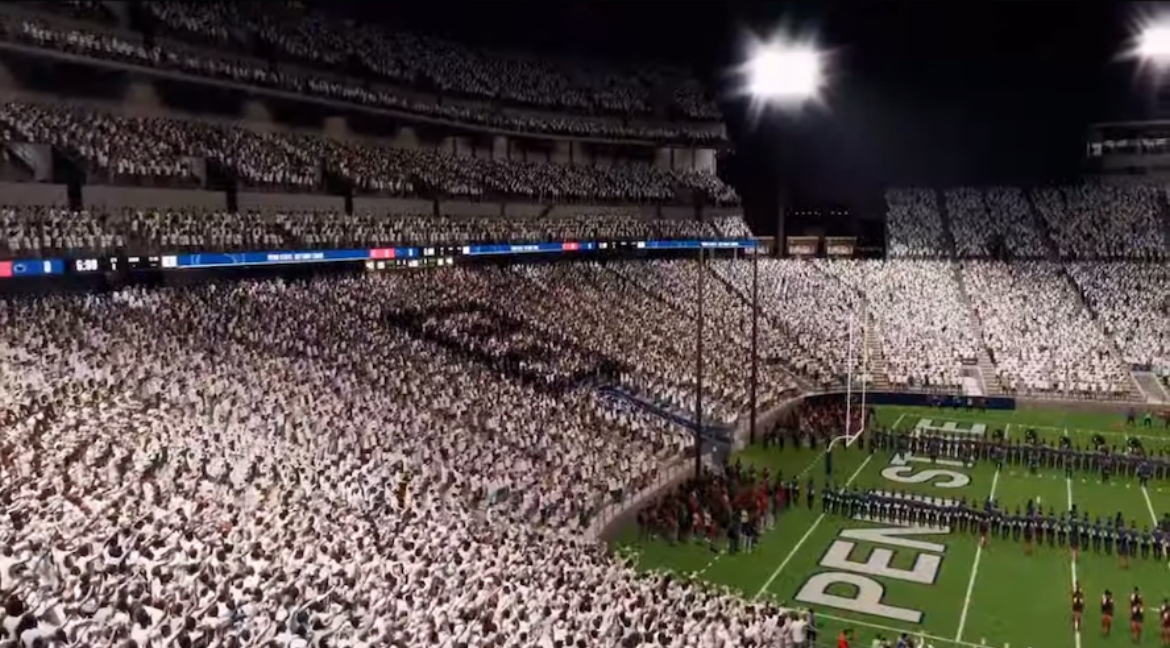UNIVERSITY PARK — A famous Happy Valley attraction is set to be featured in the soon-to-be-released “College Football 25” video game. Penn State University’s Beaver Stadium recently appeared with its classic White Out game for the video game’s trailer — making for the first college football-based video game since “NCAA Football 14.”
Developed by Electronic Arts, “College Football 25” is scheduled to come out in July.
The new video game highlights the intense atmosphere and the pulsing energy of Beaver Stadium’s crowd with a special feature called Stadium Pulse, where home team crowd noise can contribute to the performance of the visiting team. Beaver Stadium is slotted in the No. 2 overall spot for Stadium Pulse.
While details about which stadium holds the No. 1 spot in Stadium Pulse are still unknown, promotional videos from EA Sports showed Georgia at No. 2, Alabama at No. 5 and Michigan and the Big House at No. 16.
“College Football 25” shows the strides made in the world of name, image and likeness. Original NCAA football video games were able to use the branding of college football student-athletes. However, at the time the games were being released, college athletes did not typically see compensation — ultimately leading to the end of the series until now.
The Supreme Court’s 2021 decision in NCAA v. Alston was pivotal for student-athletes and led to the NCAA developing a name, image and likeness policy that permitted the athletes to earn compensation. Some states enacted their own laws surrounding name, image and likeness after the court decision.
In Pennsylvania, Senate Bill 381, Article XX-K, was signed into law by former Gov. Tom Wolf on June 30, 2021, and the law went into effect on July 1, 2021. Under state law, college student-athletes are able to earn compensation for the use of their name, image and likeness as long as it’s not related to certain products or activities such as alcohol, gambling, tobacco or other prohibited items. Furthermore, the legislation protects student-athletes who are not Pennsylvania residents, as long as the athlete is attending a Pennsylvania institution of higher education.
ESPN and other outlets reported that more than 10,000 college football players have agreed to be featured in the new game, with each being compensated around $600. The game also features a rating system for each player.
While it is not currently known how those ratings are awarded in the new game, historically, it’s been based on attributes such as strength, speed, quickness and various position-specific skills, to name a few.
For some Penn State football players, the opportunity to be featured in a video game they grew up playing is a dream come true of its own.
“I’m really excited for it,” Penn State quarterback Drew Allar told The Centre County Gazette’s media partner, StateCollege.com. “One of my hobbies outside of football is gaming. I grew up on NCAA games, but specifically (“NCAA Football 14”). That was the age where I started remembering things about video games and having a passion for it, so I’m just really looking forward to being in it.”
Penn State center Nick Dawkins echoed Allar’s sentiment when he told StateCollege.com, “I’ve been playing the game since I was young. I’m going to be in the game. Regardless, it didn’t really matter to me what the contract was like. That’s more a legacy thing. I’ll be able to pass it on to my kids that I was in a video game.”
Just as in most video games, the content game aspects shown in promotional videos are subject to change.
StateCollege.com’s Ben Jones contributed to this report.




